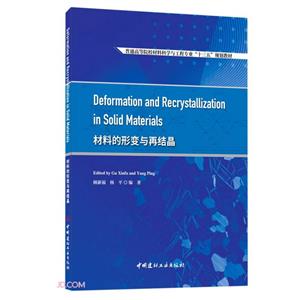-
>
湖南省志(1978-2002)?铁路志
-
>
公路车宝典(ZINN的公路车维修与保养秘籍)
-
>
晶体管电路设计(下)
-
>
无头案:雍正暴亡之谜
-
>
基于个性化设计策略的智能交通系统关键技术
-
>
花样百出:贵州少数民族图案填色
-
>
识木:全球220种木材图鉴
材料的形变与再结晶/普通高等院校材料科学与工程专业十三五规划教材 版权信息
- ISBN:9787516032374
- 条形码:9787516032374 ; 978-7-5160-3237-4
- 装帧:一般胶版纸
- 册数:暂无
- 重量:暂无
- 所属分类:>
材料的形变与再结晶/普通高等院校材料科学与工程专业十三五规划教材 内容简介
Professor Yang Ping and I are in charge of the subject " deformation and recrystallization", thus we are responsible for writing the English textbook for it. We are also working on the research field " Fundamentals of materials science and anisotropic properties of materials" controlled mainly by deformation / recrystallization or phase transformation for decades. Therefore, we are qualified for writing the textbook entitled"Deformation and Recrystallization in Solid Materials" . The lecture notes have been finished around 2016 mainly by Professor Yang Ping. I modified and enhanced them in the following years during teaching. Now, the textbook includes six chapters and is scheduled for 16 teaching hours. Exercises and examples for each chapter are prepared. We also added recent advance in deformation and recrystallization processes obtained by Electron Backscatter Diffraction (EBSD) method. The last two chapters, analytical techniques and softwares, are designed for the off-class extending reading.
材料的形变与再结晶/普通高等院校材料科学与工程专业十三五规划教材 目录
- >
新文学天穹两巨星--鲁迅与胡适/红烛学术丛书(红烛学术丛书)
新文学天穹两巨星--鲁迅与胡适/红烛学术丛书(红烛学术丛书)
¥9.9¥23.0 - >
上帝之肋:男人的真实旅程
上帝之肋:男人的真实旅程
¥19.3¥35.0 - >
大红狗在马戏团-大红狗克里弗-助人
大红狗在马戏团-大红狗克里弗-助人
¥4.4¥10.0 - >
史学评论
史学评论
¥18.5¥42.0 - >
回忆爱玛侬
回忆爱玛侬
¥10.5¥32.8 - >
山海经
山海经
¥20.4¥68.0 - >
巴金-再思录
巴金-再思录
¥19.8¥46.0 - >
随园食单
随园食单
¥20.6¥48.0
-
珠宝玉石分级和检验手册
¥12.5¥33 -
2022图书×抽奖盲袋
¥9.9¥25 -
2023读书月阅读盲盒——天黑,闭眼,刀谁?
¥42.3¥158 -
2022读者节纪念徽章-三星会员专属
¥45¥45.6 -
2023读书月阅读盲盒——我什么场面没见过?
¥42.3¥158















